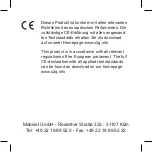
Call Guard Squelch
Each group (channel) of a conventional system can be programmed with Call Guard squelch. This feature elimi-
nates the distraction and annoyance resulting from hearing messages intended for others on the channel. It does this by
using a subaudible tone or digital code to control the squelch. This tone or code is unique to your transceiver or a group
of transceivers on that channel. Call Guard squelch is programmed by your system operator and is available on conven-
tional systems only. Multi-Net systems utilize ID codes to eliminate messages intended for others.
Transmit Disable On Busy
This feature automatically disables the transmitter if the channel is busy when the PTT switch is pressed. As long
as the PTT switch remains pressed, Call Guard squelch is disabled and any conversation on the channel is heard. If the
monitor mode is enabled by the Auxiliary switch (see “Monitoring Before Transmitting”), the transmitter keys even if
the channel is busy. In some cases, the transmitter may be disabled and the “BUSY” indication present even though no
one is talking. To key the transmitter in this situation, quickly release and then press the push-to-talk switch. If the
Transmit Disable On Busy feature is disabled by dealer programming, the transmitter keys even if the channel is busy.
Receive-Only Channels
Receive-only channels (groups) can be programmed so that monitoring but no transmitting is permitted. If the PTT
switch is pressed with one of these channels selected, the transmitter does not key, the intercept tone sounds, and “TX
DSBL” is displayed. Receive-only channels are available on conventional systems only.
Talk-Around Channels
Talk-around channels can be programmed to allow you to talk directly to another mobile without having the call go
through a repeater. (Normally, all Multi-Net and conventional calls go through a repeater.) This may permit communica-
tion when it would otherwise not be possible such as when you are out of range of the repeaters. This feature is avail-
able on conventional systems only.
OTHER FEATURES
High/Low Power Select
Some transceivers have selectable transmit power. If your transceiver has this feature (your system operator will
tell you if it does), power output can be changed as follows
:
1. Turn power on with the Auxiliary switch pressed. Then quickly press the Auxiliary switch to select “xx
POWER”.
2. Press the push-to-talk switch to select “HI POWER” or “LO POWER”. Shortly after the desired mode is selected,
normal operation resumes. “LO” is displayed when the low power mode is selected.
The low power setting increases battery life but may decrease range. The opposite may occur with the high power
setting. If your transceiver does not have selectable power, the preceding procedure can still be performed, but no
change in power occurs.








































